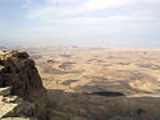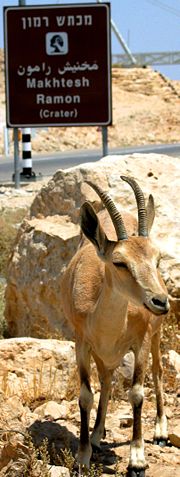
Makhtesh Ramon
Encyclopedia

Israel
The State of Israel is a parliamentary republic located in the Middle East, along the eastern shore of the Mediterranean Sea...
Negev
Negev
The Negev is a desert and semidesert region of southern Israel. The Arabs, including the native Bedouin population of the region, refer to the desert as al-Naqab. The origin of the word Neghebh is from the Hebrew root denoting 'dry'...
desert
Desert
A desert is a landscape or region that receives an extremely low amount of precipitation, less than enough to support growth of most plants. Most deserts have an average annual precipitation of less than...
. Located at the peak of Mount Negev, some 85 km south of the city of Beersheba
Beersheba
Beersheba is the largest city in the Negev desert of southern Israel. Often referred to as the "Capital of the Negev", it is the seventh-largest city in Israel with a population of 194,300....
, the landform is not actually an impact crater
Impact crater
In the broadest sense, the term impact crater can be applied to any depression, natural or manmade, resulting from the high velocity impact of a projectile with a larger body...
from a meteor
Meteoroid
A meteoroid is a sand- to boulder-sized particle of debris in the Solar System. The visible path of a meteoroid that enters Earth's atmosphere is called a meteor, or colloquially a shooting star or falling star. If a meteoroid reaches the ground and survives impact, then it is called a meteorite...
, but rather is the world's largest makhtesh
Makhtesh
A makhtesh is a geological landform considered unique to the Negev desert of Israel and the Sinai Peninsula. Although commonly known as "craters" , these formations are more accurately described as erosion cirques...
. The crater is 40 km long, 2-10 km wide and 500 meters deep, and is shaped like an elongated heart. The only settlement in the area is the small town of Mitzpe Ramon
Mitzpe Ramon
Mitzpe Ramon is a town in the Negev desert of southern Israel. It is situated on the northern ridge at an elevation of 860 meters overlooking a sizable erosion cirque known as the Ramon Crater.-History:...
(מצפה רמון, "Ramon Observation Point") located on the northern edge of the crater. Today the crater and surrounding area forms Israel's largest national park
Israel Nature and National Parks Protection Authority
The Israel Nature and Parks Authority is a government organization in Israel that manages the country's nature reserves and national parks...
, the Ramon Nature Reserve.
Formation
Hundreds of millions of years ago, the Negev desert was covered by an ocean. Slowly, this started to recede northwards leaving behind a hump-shaped hill. The hump was slowly flattened by water and climatic forces. Approximately five million years ago, the Arava Rift Valley was formed, with rivers changing their courses, carving out the inside of the crater which was a softer rock than that overlying. The crater bottom continued to deepen at a much faster rate than the surrounding walls, which gradually increased in height. As the crater deepened, more layers of ancient rock were exposed with rocks at the bottom of the crater being up to 200 million years old. Today, the crater is 500m deep with the deepest point being Ein Saharonim (Saharonim Spring) which also contains the makhtesh's only natural water source which sustain much of the wildlife in the makhtesh including onagerOnager
The Onager is a large member of the genus Equus of the family Equidae native to the deserts of Syria, Iran, Pakistan, India, Israel and Tibet...
s and ibex.
Geology
Makhtesh Ramon contains a diversity of rocks including clay hills known for their fantastic red and yellow colors and forms. Impressive mountains rise at the borders of the crater - Har Ramon (Mt. Ramon) at the southern end, Har Ardon (Mt. Ardon) at the north-eastern end, and two table mountains - Har Marpek (Mt. Marpek - "Elbow"), and Har Katum (Mt. Katum - "Chopped") along the southern wall. The hills to the north-eastern edge of the makhtesh were once entirely covered by spiral ammoniteAmmonite
Ammonite, as a zoological or paleontological term, refers to any member of the Ammonoidea an extinct subclass within the Molluscan class Cephalopoda which are more closely related to living coleoids Ammonite, as a zoological or paleontological term, refers to any member of the Ammonoidea an extinct...
fossils, ranging from the size of snails to that of tractor wheels although these have mainly been extracted so only smaller fossils can be found here today.
Giv'at Ga'ash, a black hill in the north of the makhtesh was once an active volcano which erupted thousands of years ago and caused it to be covered in lava which quickly cooled in the open air, converting it into basalt
Basalt
Basalt is a common extrusive volcanic rock. It is usually grey to black and fine-grained due to rapid cooling of lava at the surface of a planet. It may be porphyritic containing larger crystals in a fine matrix, or vesicular, or frothy scoria. Unweathered basalt is black or grey...
. Limestone covered by basalt can also be found in smaller black hills in the southern part of the makhtesh, including Karnei Ramon.
Shen Ramon (Ramon's Tooth) is a rock made of magma which hardened whilst underground. It later rose up through cracks in the Earth's surface, and today stands in striking contrast with the nearby creamy coloured southern wall of the crater, as a black sharp-edged rock.
In the centre of the makhtesh is Ha-Minsara (The Carpentry Shop), a low hill made up of black prismatic rocks, and interestingly, the rectangular pipes on the side of the hill are made of the same sort of sand found on beaches. As such, this is the only place in the world where prisms made of heated sand turned into liquid which, in cooling naturally formed rectangular and hexagonal prisms, can be seen. These prisms lost no space in the middle during formation.
The pterioid bivalve Family Ramonalinidae
Ramonalinidae
Ramonalinidae is an extinct family of marine bivalve mollusks from the late Anisian . It was an edgewise-recliner with a flattened anteroventral surface and partially fused valves. They formed distinctive mud mounds ....
is found in early Middle Triassic
Triassic
The Triassic is a geologic period and system that extends from about 250 to 200 Mya . As the first period of the Mesozoic Era, the Triassic follows the Permian and is followed by the Jurassic. Both the start and end of the Triassic are marked by major extinction events...
rocks of Makhtesh Ramon and was named after this feature.
Fauna
The Asian Wild Ass has been reintroduced to Makhtesh Ramon. In 1995 the population had increased to 40 adults in the area. The animals are hybrids of two different subspecies of the Asian Wild Ass. It is derived from the Turkmenian KulanKulan
Khulan was an empress of Genghis Khan and head of the second Court of Genghis Khan. Her status in the Mongol Empire was second only to Grand Empress Borte.-Biography:...
(E. h. kulan) and the Persian Onager
Onager
The Onager is a large member of the genus Equus of the family Equidae native to the deserts of Syria, Iran, Pakistan, India, Israel and Tibet...
(E. h. onager). The original subspecies, the Syrian Wild Ass
Syrian Wild Ass
The Syrian Wild Ass is an extinct subspecies of Equus hemionus that ranged across Syria, Jordan and Iraq.The Syrian Wild Ass was the smallest form of Equidae and could not be domesticated...
(E. h. hemippus), is completely extinct. Other larger mammals of the area include Nubian Ibexes
Nubian Ibex
The Nubian ibex is a desert-dwelling goat species found in mountainous areas of Israel, Jordan, Saudi Arabia, Oman, Egypt, Ethiopia, Yemen, Sudan, and Pakistan. It is generally considered to be a subspecies of Alpine ibex, but is sometimes considered specifically distinct...
, Dorcas Gazelle
Dorcas Gazelle
The Dorcas Gazelle , also known as the Ariel Gazelle, is a small and common gazelle. The Dorcas Gazelle stands approximately 55-65 cm . Dorcas gazelle have a head and body length of 90-110 cm and a weight of 15-20 kg...
s, Striped Hyena
Striped Hyena
The Striped Hyena is a species of true hyena native to North and East Africa, the Caucasus, the Middle East, Middle and Central Asia and the Indian Subcontinent...
s and few Arabian Leopard
Arabian leopard
The Arabian leopard is a leopard subspecies native to the Arabian Peninsula and classified as critically endangered by IUCN since 1996. Less than 200 animals remained in 2006...
s.
History
The ruins of a large prehistoric stone structure known as Khan Saharonim are found in the makhtesh as it lies along the ancient Incense Route, a trade route used by the Nabateans 2,000 years ago. These ruins acted as a way station for the traders and their animals (khan is the Arabic word for a caravansary) as they proceeding further westwards to the Mediterranean seaport city of GazaGaza
Gaza , also referred to as Gaza City, is a Palestinian city in the Gaza Strip, with a population of about 450,000, making it the largest city in the Palestinian territories.Inhabited since at least the 15th century BC,...
.
External links
- Ramon Crater on Google Maps
- Ramon Crater Detailed trail and hiking info. from Tourism, trips and travel in Israel
- Makhtesh Ramon's Visitors Center, at the Israel Nature and Parks Authority's website.

